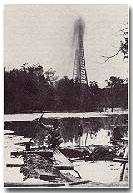OUR LEGACY - Black Gold
 Anthony Lucas' gusher at Spindletop, near Beaumont, ninety miles to Houston's northeast, erupted on January 10, 1901. Although it was not the first oil discovery in Texas, it ushered in the Texas oil boom and the petrochemical age, that changed the course of Houston's history. Spindletop's oil, as did oil from all the other gushers that followed, needed refining and distributing.
Anthony Lucas' gusher at Spindletop, near Beaumont, ninety miles to Houston's northeast, erupted on January 10, 1901. Although it was not the first oil discovery in Texas, it ushered in the Texas oil boom and the petrochemical age, that changed the course of Houston's history. Spindletop's oil, as did oil from all the other gushers that followed, needed refining and distributing.
While Beaumont's establishment displayed a remarkable lack of interest in the task, Houstonians could not have responded to the opportunity more enthusiastically. Within a few months the city emerged as the refining and distribution center of Spindletop crude. By the end of the year, a refinery had been built in the Heights, and about 50 industrial plants in the city had converted to oil-fueled energy systems. In 1902, the Southwestern Oil Company was the largest independent oil refinery in the world. In 1905, oil was discovered closer to town, in the Humble oil field of northern Harris County, seventeen miles north of Houston. The following year, the big Goose Creek oil field in eastern Harris County came through. Both Humble and Goose Creek later yielded more than 100 million barrels of oil.
Related enterprises, such as natural gas companies and oil tool manufacturing, accompanied the developing oil industry. Enjoying its new found prosperity, Houston emerged as a "new South" town.
By 1906, some thirty oil companies and seven banks had opened offices in the city. Construction of the city's first "skyscrapers," buildings as high as eight stories, began downtown. In 1910, the census counted 78,800 Houstonians, as against about 39,000 in Galveston (whose residents at present approach 70,000). Having finally surpassed Galveston, Houston did not fall behind again. Its population, in fact, continued to double in each succeeding decade to come.
In 1933, another huge oil field, the Tomball field, was discovered in northern Harris County.
In 1949, 268 oil fields operated within a 100-mile radius of Houston.






